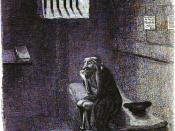Charles Dickens (1812-1870) wrote the story of "Oliver Twist" which was officially published in November 1838. "Oliver Twist" was the second of his books and followed on from the highly successful publication of the Pickwick Papers. With the success of his first book, he would have been able to write about social issues of the time, assured of a wide readership due to this, and as such, the tale of Oliver Twist could be seen by some as a social commentary on the plights and conditions of late Georgian / early Victorian Britain. I will examine in this analysis what image we get of the criminal in question and how Dickens makes a link between the 'criminal' and the city. I will also look at Dickens use of stereotypes and whether as historians we should use a work of fiction to understand the past.
Throughout the writing in the book, the character of Fagin is occasionally referenced by his name, but as in this particular section, is almost universally known as the Jew.
We are given the impression of the Jew being of the 'criminal type' or 'sub societal' by Dickens telling us that the Jew had a shrivelled body and that he 'slunk down the street as quickly as he could'. Further allusions to this are given in the passage 'As he glided stealthily along...the hideous old man seemed like some loathsome reptile, engendered in the slime and darkness...'
Use of this type of language draws a very precise picture, for the reader, of someone who fits a standardised picture of a 'criminal type', someone who slinks and is stealthy and has the same characteristics as a cold blooded animal. This will inevitably lead the reader into seeing the Jew as a criminal, even if...


